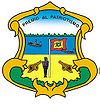Barranquilla
| Barranquilla | |||
|---|---|---|---|
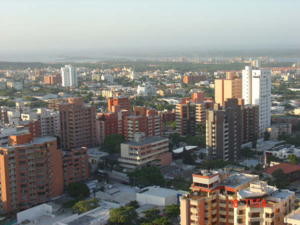 |
|||
|
|||
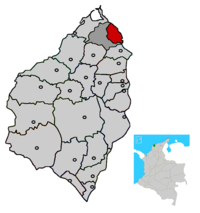 |
|||
 Barranquilla
|
|||
| Coordinates: | |||
| Country | |||
| Region | Caribbean | ||
| Department | Atlántico | ||
| Foundation | April 7, 1813 | ||
| Government | |||
| - Mayor | Alejandro Char Chaljub (Cambio Radical)[1] |
||
| Area | |||
| - City | 166 km2 (64.1 sq mi) | ||
| Population (2005)[2] | |||
| - City | 1,148,506 Ranked 4th | ||
| - Metro | 1,762,143 | ||
| HDI (2006) | 0.821 – high | ||
Barranquilla, an industrial, portuary, and special district, is a city and municipality located in northern Colombia by the Caribbean Sea. The capital of the Atlántico Department, it is the largest industrial city and port in the Colombian Caribbean region. It lies strategically by the delta of the Magdalena River, serving as port for river and maritime transportation. It is also known as the cradle of Colombian aviation and for its carnival.
It is known as Colombia's Golden Gate (Spanish: La Puerta de Oro de Colombia) as well as La Arenosa (the Sandy City). While the city bears no established record of its foundation, its settlement or foundation can be traced back to at least 1629. However, its residents traditionally have come to commemorate the city's "anniversary" as the date when Barranquilla was legally established as a village, April 7, 1813. By 1834 Barranquilla had a population of 11,212 (official census), which made it slightly smaller than Santa Marta and not quite half the size of Cartagena.[3] As Barranquilla became an important port, it also served as a haven for immigrants from Europe during World War I and World War II, and for different waves of immigrants from the Middle East and Asia.
Barranquilla was Colombia's first port and is proud of its level of industrialization and modernity, which earned it the name of Colombia's Golden Gate. The first airport in South America was also built in Barranquilla, and the world's second oldest commercial airline doing business today was founded there, SCADTA (now known as Avianca). Ernesto Cortissoz International Airport, the first airport built in South America (1919), is served by domestic and international flights.
In the 1940s, Barranquilla was the second largest city in Colombia and one of the most modern cities on the Caribbean and South America, but later local administrations, given to widespread corruption, brought about a decline in the standard of living. As government investment increased in other Colombian cities, Barranquilla's national position was surpassed. Nowadays, Barranquilla is Colombia's fourth largest city after Bogotá (capital), Medellín, and Cali as well as the most populated city on the Atlantic coast of Colombia with 2.6% of the country's population, 1,112,837 people. [1]
Contents |
History
Unlike cities in Colombia like Cartagena or Bogota D.C., Barranquilla was not founded during the Spanish colonial times and does not have a reference pre-Columbian. Is believed that their settlement was about 1629. For this reason the city does not celebrate its foundation, but the moment in which it was declared a town on April 7, 1813. It is a city born in exchange for the cultural encounter between peoples through his development as a river port during the nineteenth century. Since the last decades of the century, the main migrant groups who have entered the country, having made the city as a destination or port of call into the country. Syrian-Lebanese, German, Italian, Spanish, American, Chinese and many foreigners came to the city for several reasons.
The name of La Puerta de Oro de Colombia, more than a romantic reference, has a literal meaning: Until the development of aviation in Colombia, Barranquilla from the late nineteenth and mid twentieth century was the literal doors of the country, through which came and left passengers, goods and all that later shipped to Colombia with the rest of the world. The construction of major airports in major cities did not diminish the importance of a growing city facing one of the most trade seas in the world: the Caribbean Sea. The fact that there is a city of colonial architecture, its architecture makes it ideally Republican and therefore has a sample nation's largest Republican. The first mention of the current territory of Barranquilla dates from 1533 and was written by Gonzalo Fernandez de Oviedo y Valdes. He describes here the route of Pedro de Heredia, founder of Cartagena, just weeks before he founded that city, and says that this point was a landing of canoes of Indians from the interior of Santa Marta, who had two canoes full of dried shrimps bringing merchandise, and went to the Magdalena River to trade with this commodity, salt and other things.
However, it is known as the first permanent human settlement of the people of Indian Barranquilla Camacho. In the sixteenth century created a parcel of Captain Domingo de Santa Cruz, awarded by the Spanish crown for his outstanding performance as a soldier in the service of the Spanish Crown. This instructs disappeared in 1559, when he was in the hands of Ana Ximenez widow of Santa Cruz, who had received following the death of her husband. She herself was the victim of an outrage on the part of the second encomendero Galapa, Don Pedro de Barros I. The whole population took arbitrarily assigned Camacho was able to work and took their commission. Then, between 1627 and 1637, they founded the Hacienda San Nicolas de Tolentino by Nicolas de Barros and War, great-grandson of Don Pedro de Barros I, second encomendero Galapa. The farm was established on the banks of the channel's Tablazo. According to Domingo Castañeda Malabet the original area of the farm was of 24.78 square kilometers, but that Mr. Pedro Vasquez Buezo he sold more than 16.52 square kilometers reaching the ranch to measure 41.30 square kilometers. In this estate, Don Nicolás de Barros was the need to allow their free concerted build their houses within the estate so as to develop their projects throughout the country and help support their families. In addition, after the death of Nicolas de Barros, the estate began to hold another kind of people, people who for reasons of health, age or maintain a relationship of cronyism with the owner of the hacienda, they were allowed to live in the stay. There were also Indians from Malambo and Galapa. For 1681, the ranch was considered a site, ie a people. The farm and its surrounding sites were known as Barrancas de San Nicolas. Today it seems very logical that the City has been established on the west bank of the Magdalena River, the country's main waterway and ramp that allowed the colonization of a geographically diverse country like Colombia. However, in the Spanish colonial times had the Magdalena River delta vegetation and natural conditions made it impossible to settle on its banks.
On April 7, 1813, a date that is later institutionalized as the Day of Barranquilla, the Chairman-Governor of the Commonwealth and Independent of Cartagena de Indias, Manuel Rodríguez Torices, gives the population the title of Villa de Barlovento, capital of Tierradentro Department of recognizing the courage and patriotism of the people. Finally get the sonorous name of Barranquilla. A romantic legend promoted by the historian Juan Jose Nieto and Sunday Malabet today scientifically misleading, argued that Barranquilla was settled by ranchers in the nearby town of Galapa who left their lands looking quench the thirst of their herds in the Magdalena river. Barranquilla is a Spanish colonial city and its importance would not arrive until the second half of the s. XIX when steam navigation began on the Magdalena River.
Century XIX
In the month of October 1857, the city received that category and in the same year the three zones demarcated City Council: Lower District, Rio Arriba Barrio and the Centre. It is at that time when the city becomes more important for its booming trade policy and its strategic geographical position, becoming the first port and river of Colombia. The nineteenth century was instrumental in the development of the city when it began steam navigation, which was kept in contact with cities and towns in the interior. The voyage was in colonial Colombia and nineteenth-century the main form of transport in a country with a difficult topography. This made the most important towns in Colombia until the early twentieth century were the port towns on the coast is maritime and river. Urban centers like Cali or Medellin remained isolated from national exchange literally until the construction of railways, roads and airports.

As any sea port, the city became towards the end of the century in the first mecca of immigration of foreign peoples to Colombia and in particular the Arab Middle East. The influx of Arabs into through Barranquilla Colombia continues even today because of the pervasive conflicts of that region of the world. The Arab culture of Orthodox Christian faith, easily joined Colombian mestizo identity and contributed in every way to the development of Colombia. Because the Middle East was during the nineteenth century and until World War I in the hands of Turkey, the Arab immigrants who arrived in Barranquilla with Turkish passports, were called by the common people as "Turks", but there are dramatic differences between Turks and Arabs, of course, the Colombians did not have time because they know.
In this century, Barranquilla became the principal port of Colombia, in the late nineteenth century built the port of Puerto Colombia, which is extended to the early twentieth century and is becoming one of the longest piers in the world. The goods are moved by rail to Barranquilla, and then by river to the interior of the country. For his feature port, Barranquilla becomes one of the most cosmopolitan cities in Colombia, receiving foreigners from all over the world who settle in the city, invigorate the industry and help make it a modern city. Public companies are the first to be based in the country and during the first half of the twentieth century are those that achieve greater coverage, reaching a 100% coverage in water supply, sewerage, and a not insignificant percentage of telephone and electrical.
Century XX
In the 30s is dredged the mouth of the Magdalena River through a period of major infrastructure construction in the country and in major urban centers of Colombia with the intention of opening the economy to international markets. In 1936 they built the marine terminal, and is given the name "Golden Gate of Colombia", being the first port in the country.
During the first half of the twentieth century Barranquilla has become the fastest growing city and urban population of Colombia, growing at rates well above other Colombian cities, which was maintained until the 1970s. From the 1960s until the early 1980s, Barranquilla is plunged into an economic decline largely due to the failure of some companies engaged in industrial activity which, at the time, failed to take root in the city, keeping trade as the main economic activity. On August 18, 1993, the Congress of the Republic of Colombia, through Legislative Act No. 01 of 1993, erected the city of Barranquilla in Special District, Industrial and Port.
Geography
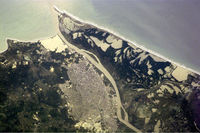
The city is located in the northeastern corner of the department of the Atlantic, on the west bank of the Magdalena River, 7.5 km from its mouth in the Caribbean Sea. Barranquilla is located at latitude 10 º 59 '16 "north of the Equator and longitude 74 º 47' 20" west of Greenwich, with reference to the Plaza de la Paz, ground zero of the city. The urban area is built on a slightly inclined plane whose extreme heights, according to the Codazzi, are 4 m and 98 m east to west. Other sources say the slopes accidental heights of up to 120 meters outside the city. According to Google Earth, the height of the city varies between 0 m in the western breakwater, up to maximum 142 m in the neighborhood of Los Nogales. Politically, Barranquilla limited to the east by the department of Magdalena (in between the Magdalena River), north to the town of Puerto Colombia and the Caribbean Sea (the swamp lands of Majorca, Puerto Mocho western breakwater), west with the municipalities of Puerto Colombia, Galapa and Tubará and south with the municipality of Soledad.
The geological composition of the region is the Tertiary period (Miocene and Pliocene) in western hills and hills and Quaternary (Pleistocene and Holocene) in the more flat, like the sole of river. According to the Geographic Institute Agustin Codazzi, the materials are Quaternary alluvial, lacustrine, fluviolacustre, marine and wind energy. Generally concerned with the banks, dikes, terraces, valleys, narrow, small alluvial fans, basins, edges of marshes, swamps, flats and hills. The materials of the Tertiary (Miocene and Pliocene) are in the western hills, and presented as varied slopes.
Climate
Barranquilla's has a tropical savanna climate (Aw) according to Koppen climate classification; it is hot all-year-round, with high levels of Relative Humidity. Average temperature is 28.4°C (85°F). Daytime temperature usually remains around 32°C (90°F). Nevertheless, from late November to early April, trade winds more or less cool it to a more comfortable temperature during daylight. During evening and through the night, temperature can change due to the strong winds it receives. Rainy seasons are from April to June and from August to November, when some streets flood producing "arroyos" (streams) that can be very dangerous, given the lack of appropriate rain drainage in some sectors of town.
| Climate data for Barranquilla | |||||||||||||
|---|---|---|---|---|---|---|---|---|---|---|---|---|---|
| Month | Jan | Feb | Mar | Apr | May | Jun | Jul | Aug | Sep | Oct | Nov | Dec | Year |
| Record high °C (°F) | 38.3 (101) |
40.6 (105) |
38.9 (102) |
38.9 (102) |
40.6 (105) |
40 (104) |
40.6 (105) |
38.9 (102) |
38.9 (102) |
39.4 (103) |
40 (104) |
42.8 (109) |
39.4 (103) |
| Average high °C (°F) | 32.2 (90) |
32.2 (90) |
32.2 (90) |
33.3 (92) |
33.9 (93) |
32.8 (91) |
32.8 (91) |
32.8 (91) |
32.2 (90) |
32.2 (90) |
32.2 (90) |
32.2 (90) |
32.2 (90) |
| Average low °C (°F) | 25 (77) |
25 (77) |
24.4 (76) |
25 (77) |
25 (77) |
25.6 (78) |
25.6 (78) |
25.6 (78) |
25 (77) |
25 (77) |
24.4 (76) |
24.4 (76) |
25 (77) |
| Record low °C (°F) | 18.9 (66) |
18.9 (66) |
18.3 (65) |
16.1 (61) |
17.2 (63) |
18.3 (65) |
18.3 (65) |
18.3 (65) |
16.7 (62) |
16.1 (61) |
16.7 (62) |
18.3 (65) |
18.3 (65) |
| Precipitation mm (inches) | 5 (0.2) |
1 (0.04) |
1 (0.04) |
25 (0.98) |
91 (3.58) |
104 (4.09) |
70 (2.76) |
102 (4.02) |
143 (5.63) |
178 (7.01) |
79 (3.11) |
24 (0.94) |
821 (32.32) |
| Source: [4] | |||||||||||||
Economy
Because of its importance in the sector of national economy, the municipality of Barranquilla passed to the category of Special District, Industrial and Port in 1993. The city is located on the first tourist region of Colombia, North Coast, the main poles of attraction as Cartagena and Santa Marta southwest to northeast. Barranquilla is a major industrial center. Economic activity is dynamic and is concentrated mainly in industry, commerce, finance, services and fishing. Among the industrial products are vegetable fats and oils, pharmaceuticals, chemicals, industrial footwear, bodies for buses, dairy products, meats, beverages, soap, building materials, furniture, plastics, cement, metalworking parts, garments clothing and boats.
Sea and river terminals are engines of industrial and commercial development of the Caribbean Region. The port of Barranquilla covers two main routes, the Magdalena River, which communicates with the interior of the country (an advantage not possessed by other ports on the Caribbean coast) and Caribbean Sea, which are traded million tonnes Europe and Asia.
With the growing expansion and demand for coal, it is feasible to build the new Deep Water Port of Barranquilla, in concession to the Sociedad Portuaria Bocas de Ceniza. The "Superpuerto", as it is called locally, will have an initial investment of $ 170 million. For future expansion provides for the use of "Superpuerto" in mixed load.
Although that is still the city is agricultural, for both agriculture and livestock juegon important role even at the base of its economy from the 70s, when frustrated long drought and cattle crops suffered from lack of water and pasture, coastal women took their role as entrepreneur and going to his natural talent, first with crafts such as gopher flowers and feathers, enrruchados hats, canvas bags and finally making clothes, work on which stands at the national level international and coastal induced man to become a trader to take the product of the coastal microentrepreneurs to beyond the borders homelands. Attracted by the booming trade, many citizens of German, American, Italian, Spanish, Syrian, Arab and Lebanese, are set out in the city, giving rise to many companies that helped strengthen the industrial and economic thrust, which made it one of the four largest cities in the country with high population density. With adequate public infrastructure, multiple tariff advantages, a modern and efficient free zone industrial parks, the capital of the Atlantic is a strategic location for international trade development.
Barranquilla is a major industrial center. Economic activity is dynamic and is concentrated mainly in industry, commerce, finance, services and fishing. Among the industrial products are vegetable fats and oils, pharmaceuticals, chemicals, industrial footwear, bodies for buses and motor vehicles, dairy products, meats, beverages, soap, building materials, furniture, plastics, cement, metalworking parts, clothing and crafts.
Education
Barranquilla is home to a number of universities, such as Universidad del Norte, Universidad del Atlántico, Universidad Metropolitana, Universidad Autónoma del Caribe, Universidad Simón Bolívar, and Corporación Universitaria de la Costa.
The city has one of highest literacy rates in the country —96.4 percent— as well as one of the highest rates of bilingualism in Colombia [2]. Marymount School,Colegio Real (Royal School), Colegio Hebreo Union, Lyndon B. Johnson School, Altamira International School, Colegio Karl C. Parrish, and British International College are a few of the local bilingual schools.
Media
The city's two main newspapers are El Heraldo and La Libertad. Other dailies include newspapers of nationwide distribution, such as Bogotá's El Tiempo. The local TV channel is Colombia's Caribbean regional network, Telecaribe. Local radio includes the customary assortment of tropical music and news. The two main highbrow alternatives, Radiodifusora Nacional de Colombia and Uninorte FM Estéreo, broadcast on 640 AM and 103.1 FM, respectively.
Transportation
Public transportation consists of a BRT System (Transmetro), as well as privately owned buses and taxis.
Recently, an illegal form of transportation denominated mototaxismo developed. A regular motorcycle is used to carry a passenger for a lower fare than a bus or taxi. This unregulated and potentially dangerous practice has led to protests by the legally operating transport companies and drove many of them into bankruptcy.
The city's airport, Ernesto Cortissoz International Airport, receives domestic and international flights.
Literature
Barranquilla was home to Nobel Prize winner Gabriel García Márquez during his early years as journalist and bears substantial weight on his literary production. García Márquez's old bohemian hangout, La Cueva, has been restored and is open to the public as an artsy bar. It was here that the writer met with the Grupo de Barranquilla, an informal group of local writers and journalists.
Music
Barranquilla hosts "Barranquijazz" (a jazz festival) in September, and "Miche Rock Festival", a rock festival sponsored by local musical instruments store Miche.
Sports
Though baseball is popular, the locals fervently follow Barranquilla's soccer team, Atlético Junior. The team plays at the Estadio Metropolitano Roberto Melendez.
Shooting sports, Basketball, Auto racing, Boxing, Golf and Tennis tournaments also take place in the city.
Arts
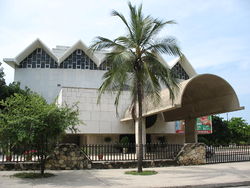
[[Teatro Municipal Amira de la Rosa] is the city's main cultural scenario. Barranquilla is also home to Cinemateca del Caribe, Alliance Française (Barranquilla Chapter), Centro Cultural Avianca, and Centro Colombo Americano. Performances by touring bands or artists are usually held at Estadio Metropolitano Roberto Melendez.
Carnival (Mardi Gras)
Barranquilla's Carnival (Spanish: Carnaval de Barranquilla) is celebrated during the four days before Ash Wednesday and is one of the world's largest carnivals, among the Brazilian carnival in Rio de Janeiro and Carnaval de Veracruz in Mexico. In November 2003, UNESCO proclaimed it as one of 28 different "Masterpieces of the Oral and Intangible Heritage of Humanity."[5]
Notable people from Barranquilla
- Nina Garcia, fashion director at Marie Claire and judge on the Bravo reality television program Project Runway
- San Francisco Giants shortstop Edgar Rentería
- Actress Sofía Vergara
- Pop singer Shakira
Sister cities
Sister cities of Barranquilla include:
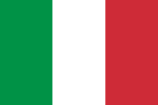 Lecce, Italy
Lecce, Italy Buenos Aires, Argentina
Buenos Aires, Argentina Tampa, Florida
Tampa, Florida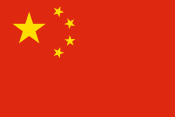 Nanjing, People's Republic of China
Nanjing, People's Republic of China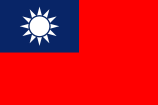 Kaohsiung, Taiwan
Kaohsiung, Taiwan
References
- ↑ (Spanish) National Registry of the Civil State: 2007 regional elections
- ↑ (Spanish) DANE 2005 Census: Barranquilla
- ↑ Nichols, Theodore E. (May 1954) "The Rise of Barranquilla" The Hispanic American Historical Review 34(2): pp. 158-174
- ↑ www.ideam.gov.co
- ↑ UNESCO: Barranquilla's carnival
External links
- (English) Barranquilla travel guide from Wikitravel
|
|||||||
